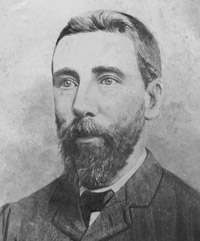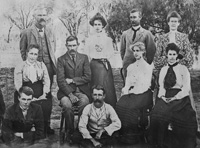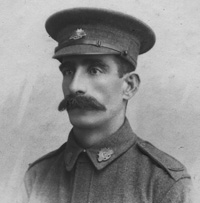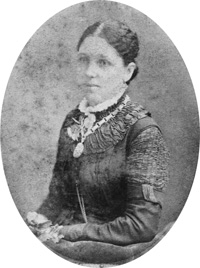There were some well-known McIntyres that settled in the Hunter from the 1830s among them Peter McIntyre, grazier and his brothers and the Rev William McIntyre,a renowned free Presbyterian. Another family was that of John and Anne who were living near Butterwick when their first child, Julia was born (April 1844, baptised April 1845). There were two other children, Thomas Campbell (baptised 22 Dec 1846 Upper Hunter parish, Lochinvar, recorded as MacIntyre) and James Alexander (baptised 12 May 1849, Whittingham parish, later said to be Aberdeen). John was a schoolteacher.
What we know of the emigrant parents is based on these baptism records. There appears to be no other evidence of marriage or deaths and burial of John and Ann (Inch) McIntyre or their settlement in the Hunter. They were neither convicts nor arrivals on Dunmore Lang’s Scottish bounty ships of the 1830s. It seems likely they came as free emigrants in steerage some time before 1845.
The baptism records give the parish locations rather than the names of settled places. Middlehope, Seaham and Butterwick is the lower Hunter near Morpeth and Hinton. The family must have moved further into the Hunter, with Thomas baptised in Upper Hunter parish (near Lochinvar) and James in Whittingham parish near Aberdeen. In the 1840s these were thriving centres of pastoral and agricultural production and commerce.
It is known John was a school teacher (Julia baptism) though he may have worked in some other capacity in the expanding settlement. It is possible he had employment in a denominational school, the main form of schooling for those children whose parents could afford the fees. In 1848, a committee in Hinton established one of the first 'national schools' before the public school was established in 1866 (according to C J Mitchell's excellent Hunter's River, 1984). In Hinton, before the Anglican church was built in 1857, Rev Augustus Middleton celebrated services at his property 'Moore Park'— it was he who baptised Julia in 1845.
Family tradition as told by Lorna McIntyre says that the parents died leaving the young children to be adopted by other families (they were aged two, five and seven in 1851), though there is no death or burial record for either parent so far located to confirm a date. Records may not survive fire and flood. It is known that the Seaham cemetery records (first burial 1838) were destroyed when a 1935 bushfire razed some surviving colonial buildings. The digitisation of old newspapers by the National Library of Australia promise much but searches have not so far revealed any further trace of John and Anne.
There is some evidence for the adoption of Thomas Campbell and Julia by another Hunter family. Apparently separated from their brother, these children had a close connection to another McIntyre family who are equally hard to trace in its first generation. John Campbell McIntyre (no birth record, possibly Maitland, 1851) had a lifelong association with Thomas Campbell McIntyre who was about the same age and shared the same middle name. It is possible the two immigrant families were related, a surmise that will only be confirmed further UK research.
John Campbell McIntyre settled in Coonamble on the Castlereagh River after he married Margaret Clare (nee White) in 1872. They had numerous children. It happens that Julia, the older sister of Thomas and James was living in Coonamble when she married Alfred Edwards in 1879, with whom she had two children, one surviving (Alfred jnr). Her infant daughter Susan died in 1882 and Julia followed a year later and was buried in Coonamble in 1883.
|
It appears James was adopted by a Brisbane family since it is known he was living there by age three (unknown source, possibly the Moreton Bay 'separation index') and was later employed by Alexander Stewart and Sons. (This Scot did not adopt James Alexander as oral tradition has it, since Stewart's is a much later arrival in Brisbane).
James was a successful Brisbane draper by 1872, the year he married Elizabeth Margaret Sneyd, the daughter of a prominent government official, Samuel Sneyd. They had four children, three surviving (David Campbell Hanley, Lillian Julia Anne and James Alexander). James Alexander senior died aged 43 in Brisbane, but Thomas was 80 when died in Kogarah, Sydney in 1926. It is interesting that 'Campbell' is one of the family names.
The connection with Coonamble McIntyres continued into the next generation. By 1914, three of John Campbell McIntyre's sons were in Queensland farming on the Darling Downs. One of these sons, Edgar (Alford) Joseph (born Coonamble 1882) was engaged to Lillian Julia McIntyre when he enlisted at Toowoomba in the 26Bn AIF. He died of wounds in August 1918, after Mont St Quentin.
At the time of his enlistment Edgar was farming with Thomas at Bell near Dalby on land John Campbrell had selected (according Frederick J McIntyre's research). Also living nearby was another 'James Alexander', a Coonamble brother of Edgar's. This James was a blacksmith living in Quinalow when he married Mary Grant in 1909. In the family archive is group photograph from this time that may show some of these family members known to Thomas. It is thought that Edgar is the man seated cross-legged at the front (Figure 2) and that he sent the photo to Lillian. Thomas may be the older man, rear left.
Further evidence supporting the interpretation that Thomas and Julia were adopted by John Campbell's parents has been found in Edgar's WWI records. These contain letters from Thomas to Army Records in 1922 where he states that he is the dead soldier's father, accepts his medals and claims the war gratuity. Was this the desperation of an old man 'too old to work' as he stated, or was it that Thomas felt himself to be kin by long family association? In fact, Thomas was married in Newcastle in 1881 to Frances Thurlow and they appear to have had no children, certainly not Edgar.
Oral tradition, handed down by Lorna McIntyre (1906-1989) via her aunt Lillian Julia, knew this Coonamble association and its earlier links to the colonial past. They knew Thomas as an old rustic called 'Grandpa' or 'Uncle' but 'never by name' when he came on his visits to Brisbane. It doesn't seem they recognised him to be grandfather McIntyre's surviving older brother. Though the grieving Lillian regarded her fiancee Edgar as her cousin, there is no support in the records for this degree of relationship.
Some possibility remains of finding evidence in Hunter valley genealogy of these early McIntyres who have otherwise vanished into the colonial past virtually wqithout trace.
This information was prepared by John McIntyre, descendant of James Alexander and David Campbell Hanley McIntyre. Thanks to Frederick McIntyre of Kingaroy, Qld (grandson of John C McIntyre) for his assistance.
Comments and enquiries are welcome and can be sent to john@artpages.com.au
|
 |
| James Alexander McIntyre about 1885 |
 |
| Queensland family group c1910, from family archive. Click to enlarge. The man seated crosslegged, centre, may be Edgar McIntyre. |
 |
| Edgar Joseph McIntyre, 26Bn AIF, died in France Aug 1918 |
 |
| Unknown family member c1880. From the family archive. |
|